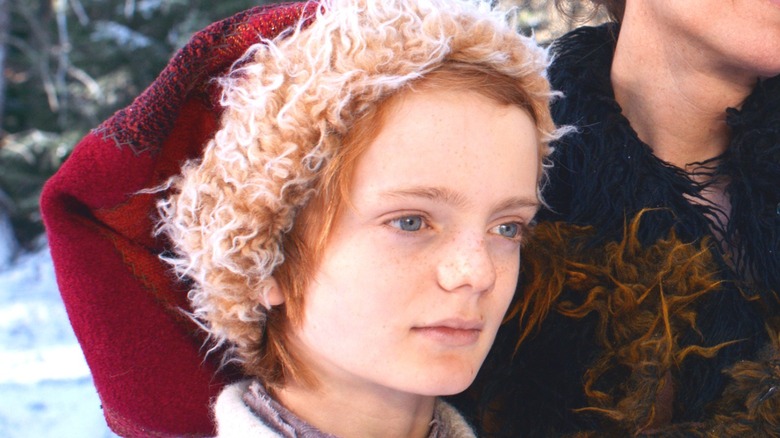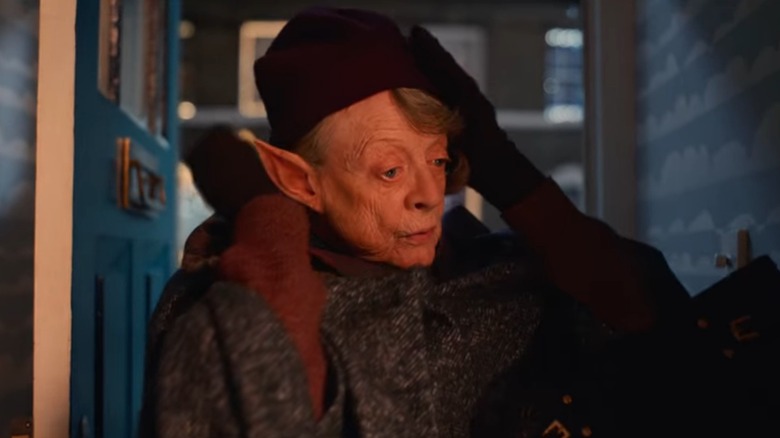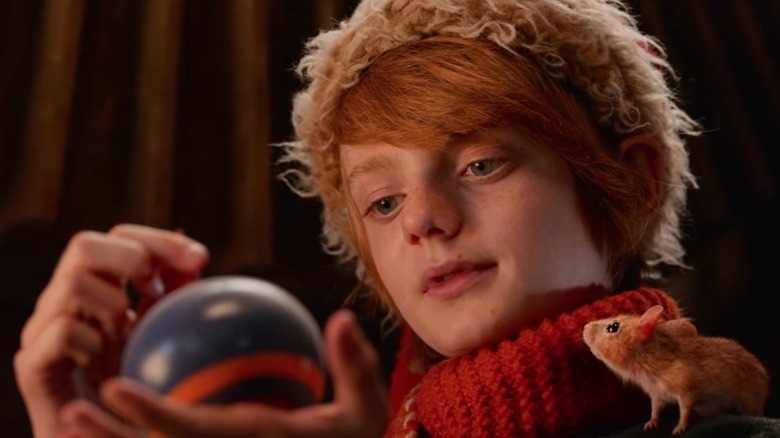The Ending Of A Boy Called Christmas Explained
One of the warmest new Christmas movies this year is Netflix's "A Boy Called Christmas," an adventurous tale about a young boy who believes in magic and seeks hope. It's based on the children's novel of the same name by Matt Haig and is getting lots of love from families this season.
Nikolas (Henry Lawfull) has heard the tale of the magical town Elfhelm all his life. Although the happy village seems awfully far from his tough life in a cold Finnish forest, where he lives with his woodcutter father, Joel (Michiel Huisman), he believes it's out there. So, when the King (Jim Broadbent) asks his subjects to bring back something magic, Nikolas sets out to find Elfhelm.
After a dangerous trek through the frigid landscape, a sign of magic in the form of a talking mouse, and the revelation that Elfhelm isn't as happy as it once was, Nikolas must put things right. Though he loses his father in the process, he returns a kidnapped elf child to Elfhelm and heals the town. Together, they bring their holiday of kindness and chocolate — Christmas — to the hopeless subjects of the King, creating a new tradition in the process.
A Santa Claus origin story
At its core, "A Boy Called Christmas" is an origin story for Santa Claus. The name is never mentioned in the movie, but his other monikers — Father Christmas, Saint Nicholas — are fully present. Author Matt Haig got the idea for the story when his son asked what Santa Claus was like as a kid (via Red Carpet News TV). That's where little Nikolas comes in: He's missing the round belly, red suit, and white beard normally associated with Santa Claus — those will come with time — but he's got the red stocking cap, a flying reindeer named Blitzen, and a pure belief in magic.
Screenwriter and director Gil Kenan ("Monster House," "Ghostbusters: Afterlife") told ScreenRant he was inspired by the joy, awe, and fear that accompany the anticipation of someone sneaking into your bedroom and leaving a gift. "It just gives such a mystique to the person who would actually enter your home, and what made them tick," he said. "A Boy Called Christmas" unravels this mystique to reveal a hopeful boy who perseveres through hard times and wants to bring kindness to those around him.
He almost doesn't make it that far, though, because the fearful and powerful witchy elf Mother Vodol (Sally Hawkins) freezes him in his tracks — until she discovers that she once knew his mother. That tale of Elfhelm that Nikolas' mom told him every night? It was an autobiography.
Finally, the end of the movie shows the very first Christmas on which Saint Nick delivers presents to children in the middle of the night, climbing in through chimneys to give the kids hope in the form of a handmade toy. He commits to doing it each year, so after distributing all the gifts, Nikolas probably flies Blitzen back to the north, where he and the elves get started on making toys for the next year.
Aunt Ruth is the Truth Pixie
The final scene of "A Boy Called Christmas" brings the movie back to its framing device as a bedtime story: Aunt Ruth (Maggie Smith) is babysitting three young children who, like Nikolas, have recently lost their mother — and their joy. By the end of the tale, she's brought a spark of hope back to the kids, and a colorful array of Christmas decorations magically appear in their living room.
Ruth, it turns out, is more than she seems. She says, "I never lie," and reveals her long, pointy ear when she adjusts her hat. Then, as she's walking away from the house, she lets loose a firecracker into the sky. All these clues add up to the revelation that Aunt Ruth is the Truth Pixie who helps Nikolas earlier in the movie. Her name was a clue all along, as "Ruth" is just a letter shy of "Truth."
This framing device serves up that fun reveal at the end, but it also puts one of the movie's themes front and center: the magic of stories. In an interview with Red Carpet News TV, Matt Haig said, "I really do think stories have the power to save us." He backed this idea up by explaining that change is an essential ingredient of stories, so when someone is feeling stuck and hopeless, stories can give them faith that the future will be different. In other words, stories give people hope. "A Boy Called Christmas" is about "believing in things that feel impossible when life is tough," he said.
While that idea becomes literally magical in Nikolas' story — hence the talking mouse — it's grounded in reality in the modern kids' story: After losing their mother, finding joy feels impossible, but Aunt Ruth's story makes them believe it isn't. This may go over the heads of kids watching the movie, but adults will surely notice the true purpose of Ruth's story.
The true meaning of Christmas
The term "Christmas spirit" is thrown around all the time, and it oftentimes becomes an empty phrase, but "A Boy Called Christmas" returns to the emotional roots of the holiday. While Christmas is technically a Christian holiday, celebrating the birth of Jesus, many of the traditions associated with it come from pagan celebrations of the winter solstice.
In the Northern Hemisphere, the December solstice is the shortest day — and longest night — of the year, making it a time associated with cold, dark, and hardship. However, it also signals the end of all those things. When talking about the origin of Christmas traditions, like evergreen trees, historian Kenneth C. Davis told CBS News, "All of these things celebrate the idea that life and light are coming back into the world, which is essentially what Christmas means to Christians around the world."
"A Boy Called Christmas" doesn't have a lick of religion in it, but instead infuses the story of a pagan Christmas with themes of grief and recovery. The modern children and Nikolas are all grieving the loss of their mothers, so Christmas represents the idea that things will change and they will be able to find joy again. That theme has special significance to Matt Haig. Before writing "A Boy Called Christmas," he published the nonfiction book, "Reasons to Stay Alive," an account of his struggles with depression and suicidal thoughts — and how he came back from them. Nowadays, he said to BBC News, each of his books are about looking for hope in a dark place. Sometimes that dark is literal, like a long winter night, but other times it's simply metaphorical, like the loss of a loved one.



